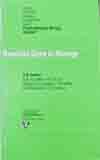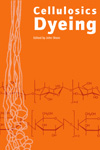Can you suggest a monofunctional reactive black dye?
Name: Marlin
—ADVERTISEMENTS—
Victor B. Ivanov's

Reactive Dyes in Biology and Medicine
Explains use of reactive dyes for staining proteins or carbohydrates
Waring and Hallas's

The Chemistry and Application of Dyes (Topics in Applied Chemistry)
includes recipes for synthesizing reactive dyes
Heinrich Zollinger
Color Chemistry: Synthesis, Properties, and Applications of Organic Dyes and Pigments
John Shore's

Cellulosies Dyeing
Useful information about the chemistry of reactive dyes, and other dye types
Is there any particular reason why another color, such as navy blue, will not do? There are a great many more reactive navy blue dyes. There is even a little bit of overlap in names or colors between some of the reactive blacks and some of the reactive dark blues. In fact, reactive black 5 itself has a distinctly bluish cast.
Here's a list of the unmixed reactive black dyes for which I have some information, in order of their Colour Index names:
1. reactive black 1, a monochlorotriazine dye (Procion Black H-G). Appears to be a chromium-cobalt complex.
2. reactive black 5, a vinyl sulfone (Remazol Black B). Bifunctional.
3. reactive black 8, a monochlorotriazine (Procion H-N). Appears to be a chromium-cobalt complex.
4. reactive black 13 (Cibacron Grey G-E).
5. reactive black 23 (Cibacron Pront Grey 2 B).
6. reactive black 26, a methylsulfonyl dye (Levafix Black P-G).
7. reactive black 31, a vinyl sulfone (Remazol Black RL). Looks bifunctional.
8. reactive black 39, a monochlorotriazine (Procion H Blue P2R). Looks monofunctional.
9. reactive black 49. (Dycrofix Blue P3R). Looks monofunctional. Actually reactive blue 49.
10. reactive black 160, monochlorotriazine (Black HEBL). Looks bifunctional. Actually reactive blue 160.
There is no reason to believe that my list is complete, though these are the most likely to be locatable.
More details on the above list:
1. Reactive Black 1, Procion Black H-G. CAS Number: 12236-77-0. Molecular Formula: C23H13ClN8Na2O10S2 [this formula omits the chromium and cobalt]. Synonyms:
1-Naphthalenesulfonicacid,4-[[6-[(4-amino-6-chloro-1,3,5-triazin-2-yl)amino]-1-hydroxy-3-sulfo-2-naphthalenyl]azo]-3-hydroxy-7-nitro-, chromium-cobalt complex (9CI); C.I. 17916; Cibacron Black BG; Cibacron Black BG-A; Cibacron Black FBG-A; Cibracron Black BG-A; Procion Black H-G. Available from Sigma Aldritch as Cibacron Black FBG-A.
2. Reactive Black 5, which you've already rejected for its bifunctionality, is the easiest-to-find reactive black dye (that is not a mixture of other colors). It is symmetrical with its two reactive ends, as shown in the molecular structure drawing below.

Its full chemical name is [2,7-naphthalenedisulfonic acid, 4-amino-5- hydroxy-3,6-bis((4-((2-(sulfooxy)ethyl)sulfonyl)phenyl)azo)-tetrasodium salt], while its formula is C26H21N5Na4O19S6, CAS Reg. No. 17095-24-8. The formula will be useful below for comparing to a dye for which little other information is available.
3. Reactive Black 8, also known as Black DN or Black HN, is a monofunctional black reactive dye, in the monochlorotriazine (Procion H) group, but, like Reactive Black 1, it is described as occurring in a 1:2 chromium-cobalt complex of two dye molecules per metal atom. When complexed to chromium alone, the dye produces blue, while when complexed to cobalt alone, it is reddish. Synonyms: C.I. 18207; Cobalt 5-[(4-amino-6-chloro-1,3,5-triazin-2-yl)amino]-4-hydroxy-3-[(2-hydroxy-5-nitrophenyl)azo]-2,7-naphthalenedisulfonic acid complex; Basilen Black P-BR; Cibacron Black B-D; Drimarene Black P-BL; Helaktyn Black DN; Kayacion Black P-N; Ostazin Black H-N; Procion Black H-N; Procion Black P-N; Reactive Black K-BR; Reactive Black MN. CAS Registry Number 12225-26-2.

[picture from Industrial dyes: chemistry, properties, applications, by Klaus Hunger, p. 312 (John Wiley and Sons, 2003).]
I have another picture of Reactive Black 8; unfortunately I cannot determine its source. What's interesting about it is that it contains essentially the same dye molecule as the picture above, but with no mention of the chromium or cobalt, nor of a complex of two or more dye molecules:

The fact that a dye takes the form of a dimer complexed with chromium and/or cobalt makes little difference to most purposes, but might be a real problem in cases in which only a monofunctional dye will do. Having seen these two different drawings for what is essentially the same dye, I think we may need to wonder about whether any single monofunctional dye is involved in a similar complex.
4. Reactive Black 13. Cibacron Grey G-E; Hicion Grey HE-G; CAS 12225-31-9. I have no more information on this dye. Sigma Aldritch carries it; contact them for more information.
5. Reactive Black 23. Cibacron Pront Grey 2 B. I have no more information on this dye. Sigma Aldritch carries it; contact them for more information.
6. Reactive Black 26. Levafix Black P-G; Levafix Black E-2G. CAS 12731-61-2. I have no more information on this dye.
7. Reactive Black 31 is listed as being in the Remazol series. Synonym: Black RL. CAS# 12731-63-4
I do not have the molecular structure of the dye reactive black 31, but I have a molecular formula:
C29H20N6O17S4•4Na
Comparing that to the molecular formula of reactive black 5, C26H21N5Na4O19S6, the two look similar in size, which leads me to suspect that reactive black 31 may also be a bifunctional dye.
It is carried by Jagson and Shivitex; the latter provides fastness ratings for this dye.
8. Reactive black 39 is in the Procion H series, sold by Jagson as Dycrofix Blue P2R (their color chip shows a pale gray). Synonyms: Jagson's Dycrofix Blue P2R; Ostazin Blue H-2G; possibly Cibacron Navy G.

Picture source: Environmental chemistry of dyes and pigments, Abraham Reife, H. S. Freeman, page 12 (Wiley-Interscience, 1996).
9. Reactive black 49. This appears to be a misprint for Reactive Blue 49. Jagson shows Reactive Blue 49 with a black color chip, so it's worth considering in spite of its name.
Synonyms: 2-Anthracenesulfonicacid,1-amino-4-[[3-[[4-chloro-6-[(3-sulfophenyl)amino]-1,3,5-triazin-2-yl]amino]-2,4,6-trimethyl-5-sulfophenyl]amino]-9,10-dihydro-9,10-dioxo-,sodium salt (1:3); Cibacron Blue 3R; Cibacron Blue P 3R; Cibacron Brilliant Blue 3R-P; Helaktyn Blue D 3R; Kayacion Blue P 3R; Levafix Blue PN 3R; ProcionBlue P 3R; Procion Brilliant Blue H 3R;. CAS 72927-99-2. Molecular Formula: C32H26 Cl N7 O11 S3 • 3 Na

Structure from http://www.lookchem.com/cas-729/72927-99-2.html. It looks like a Procion H type (monochlorotriazine).
10. Reactive black 160 is sold by Jagson as Black HEBL, with a medium gray color chip. (See http://www.jagson.com/reactive_dyes.htm). They don't give any other identifying numbers. Chemicalregister.com lists a reactive black 160, but it appears to be a misprint for reactive blue 160. Here's their image for reactive black 160:

Here's an image of reactive blue 160, from guidechem.com, which is easier to read but does appear to be the same molecule: you can see two aminochlorotrizine (monochlorotriazine) groups in it.

(Please help support this web site. Thank you.)
Posted: Wednesday - June 01, 2011 at 09:03 AM All About Hand Dyeing Q&A Previous Next
Follow this blog on twitter here.
- Top of this blog -
- FAQ -
- The Dye Forum -
- How to Tie Dye - How to Batik -
- Books - Toys - Plants -
More in this category:
- -
Follow this blog on twitter here.
Calendar
Search
Categories
- about dyes
- batik
- big projects
- business of dyeing
- changing color of clothing
- chemistry of dyeing
- color mixing
- disasters and problems
- discharge (bleach) dyeing
- dye & fiber choice
- dye application
- dye safety
- dyeing acrylic
- dyeing furniture
- dyeing nylon
- dyeing objects
- dyeing polyester
- finding a dyer
- fixing dye
- immersion or vat dyeing
- miscellaneous
- natural dyes
- pigments and fabric paint
- rainbow dyeing
- removing dye
- satin can be any fiber
- schoolwork
- screen prints & dye
- they want to sell us dyes
- tie dye parties
- tie-dyeing, resists, shibori
- washing out after dyeing
- where to get dyes and supplies
Archives
XML/RSS Feed
Statistics
All About Hand Dyeing Q&A: 2223
about dyes: 176
batik: 57
big projects: 12
business of dyeing: 8
changing color of clothing: 357
chemistry of dyeing: 105
color mixing: 53
disasters and problems: 68
discharge (bleach) dyeing : 32
dye & fiber choice: 209
dye application: 72
dye safety: 49
dyeing acrylic: 2
dyeing furniture: 49
dyeing nylon: 46
dyeing objects: 33
dyeing polyester: 125
finding a dyer: 50
fixing dye: 106
immersion or vat dyeing: 20
miscellaneous: 127
natural dyes: 30
pigments and fabric paint: 48
rainbow dyeing: 11
removing dye: 63
satin can be any fiber: 9
schoolwork: 43
screen prints & dye: 12
they want to sell us dyes: 2
tie dye parties: 23
tie-dyeing, resists, shibori: 56
washing out after dyeing: 32
where to get dyes and supplies: 133
– ADVERTISEMENTS –
Tie-dye kits make great gifts!
Total entries in this category:
Published On: Aug 29, 2012 02:49 PM

 Syndicate this site
Syndicate this site